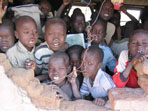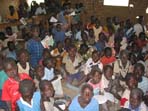A young farmer from Yiriol in eastern Bahr El Ghazal province, Marial waits to be officially registered at a UN refugee agency reception centre so that he can receive food from WFP and other aid.
“We are all Sudanese and proud of our country. If peace is stable, we will go back," he explains. "But we just don’t know if the interim period will bring us war, separation or unity.”
VOTING WITH THEIR FEET
Six years before a scheduled referendum on whether the south should become independent from the rest of Sudan, hundreds of southerners – most of them young men – are voting with their feet to become refugees at Kakuma, which is facing a break in the pipeline of WFP food for the camp’s 87,000 refugees.
The UN High Commissioner for Refugees says more than 840 Sudanese have arrived in Kakuma since 1 January. Very few have gone in the other direction and UNHCR isn’t encouraging refugees to leave in large numbers until the south can take them in.
“In the south, there’s no work, no schools, no hospitals - there’s nothing,” says Marial, contrasting life at home with conditions in the camp, where refugees receive free food, accommodation, school education and medical attention.
FOOD SHORTAGES AND FIGHTING
 Marial describes Yiriol as particularly unstable, with a drought last year that sparked food shortages and fighting between local tribes over land. Marial describes Yiriol as particularly unstable, with a drought last year that sparked food shortages and fighting between local tribes over land.
Both the Sudan People’s Liberation Army and the Government of Sudan were recruiting young men into the armed forces amid rising tensions over how the peace agreement would be implemented.
“Another reason we left is that now there is no peace for Sudan as a whole," says Marial. "In the west, there is war. And if the SPLA and the government armies have to integrate, people from the south might have to fight in Darfur.”
Marial lost track of his parents 10 years ago during the civil war. Having brought his seven brothers and sisters to Kakuma, he wants to study international affairs in Kenya. He hopes eventually to become a diplomat for the new Sudan.
CIVIL WAR AND FAMINE
Two decades of civil war and related famine have killed an estimated two million people in south Sudan and displaced four million inside the country, Africa’s largest. Another 560,000 south Sudanese have fled to neighbouring countries.
“The 230,000 refuges in Kenya depend on WFP food from a number of donors,” said Tesema Negash, WFP’s Country Director in Kenya, during a visit to Kakuma with U.S. Ambassador William Bellamy. Through WFP, the United States annually provides more than 50 percent of the food aid for Kakuma.
“WFP has managed to sustain a very healthy pipeline up until now thanks to the generous contributions of donors. But by April, we expect an almost complete break of cereals. By May, probably other commodities will run out,” Negash warned.
BRIDGING THE SHORTAGE
 Negash said that new shipments for Kakuma were expected to arrive from the United States in July or August, so WFP had appealed to donors for cash to bridge the shortage by buying food locally. WFP hoped the U.S. ambassador’s visit would send a signal to other donors to do more for the refugees in Kenya. Negash said that new shipments for Kakuma were expected to arrive from the United States in July or August, so WFP had appealed to donors for cash to bridge the shortage by buying food locally. WFP hoped the U.S. ambassador’s visit would send a signal to other donors to do more for the refugees in Kenya.
He added that according to a recent UNHCR survey of refugees, most were anxious to go home. “But when will this happen? We don’t know,” Negash said.
“It all depends on what is available for these people in Sudan. The health facilities, the schools, shelter, roads, de-mining. All these will have to appear in Sudan for these people to go back. And until this happens, I doubt there will be a big influx of refugees from Kenya and elsewhere and back into Sudan.”
Marial agrees. “Perhaps we’ll have to stay here for years,” he says.
|